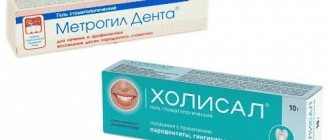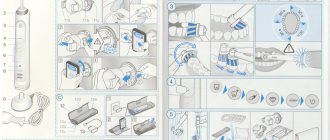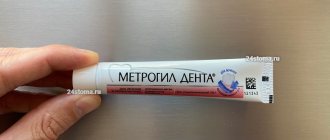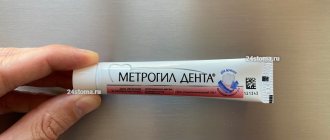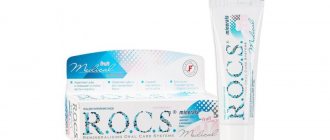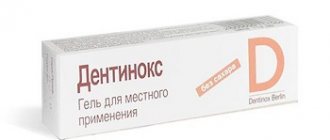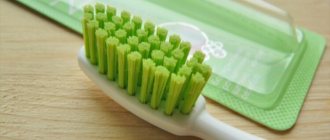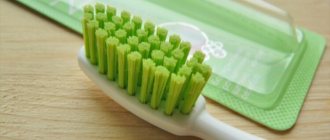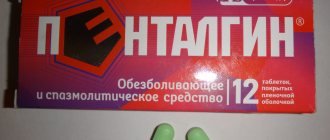Some children experience the period of teething baby teeth and their replacement with permanent molars painlessly and calmly, while others, on the contrary, are forced to feel excruciating pain. In the latter case, only special medications can alleviate the child’s condition, for example, pain-relieving gels during teething.
Nosological classification (ICD-10)
- B37.0 Candidal stomatitis
- K00.7 Teething syndrome
- K05 Gingivitis and periodontal diseases
- K12 Stomatitis and related lesions
- K13.0 Diseases of the lips
- K13.7 Other and unspecified lesions of the oral mucosa
- L43.9 Lichen planus, unspecified
- L51.9 Erythema multiforme, unspecified
- Z100* CLASS XXII Surgical practice
- Z97.2 Presence of dental prosthetic device (complete) (partial)
Note!
The description of the drug Cholisal gel tube 10g on this page is a simplified author’s version of the apteka911 website, created on the basis of the instructions for use.
Before purchasing or using the drug, you should consult your doctor and read the manufacturer's original instructions (attached to each package of the drug). Information about the drug is provided for informational purposes only and should not be used as a guide to self-medication. Only a doctor can decide to prescribe the drug, as well as determine the dose and methods of its use.
Pharmacodynamics
Choline salicylate has analgesic, anti-inflammatory and antipyretic effects. It inhibits the activity of cyclooxygenase, the functions of macrophages and neutrophils, the production of interleukin-1 and inhibits the synthesis of PG. It also has antimicrobial and antifungal effects (in acidic and alkaline environments).
The analgesic effect appears within 2–3 minutes and lasts 2–8 hours.
Cetalkonium chloride has an antiseptic effect on bacteria, fungi and viruses.
Cholisal does not contain sugar, does not have a local irritating effect and is well tolerated by patients.
Cholisal 10 g dental gel
Instructions for medical use of the drug CHOLISAL® Trade name Cholisal® International nonproprietary name No Dosage form Dental gel Composition 1 g of gel contains active substances: choline salicylate 87.10 mg, cetalkonium chloride 0.10 mg, excipients: hydroxyethylcellulose, methyl parahydroxybenzoate, propyl parahydroxybenzoate, glycerol, oil anise, ethyl alcohol 96%, purified water to 1.0 g. Description Transparent, colorless, homogeneous mass with the smell of anise oil. Pharmacotherapeutic group Antimicrobial drugs for local treatment of oral diseases. Other. ATX code A01AB11 Pharmacological properties Pharmacokinetics Choline salicylate is rapidly absorbed from the mucous membranes (approximately 2 times faster than acetylsalicylic acid). Salicylates easily penetrate most tissues and body fluids. They exhibit high affinity for blood proteins and tissues, binding to blood plasma albumin in the range from 50 to 80%. The half-life of salicylates ranges from 2 to 4 hours. The biotransformation of salicylates to salicylic acid occurs in organs and tissues, mainly the liver, with the formation of salicylic acid, glucuronides, acetal, and gentisic acid. The resulting biotransformation products are excreted in the urine (75% is salicylic uric acid). About 10% of salicylates are excreted unchanged in the urine. Elimination is slow: about 50% of the dose is eliminated within 24 hours. Pharmacodynamics The drug uses the synergistic effect of the components: anti-inflammatory, analgesic and local disinfectant. The main active ingredient in the drug, choline salicylate, has a local anti-inflammatory and mild analgesic effect. The mechanism of the analgesic, antipyretic and anti-inflammatory action of salicylates is associated with inhibition of the activity of prostaglandin cyclooxygenase, as well as the activity of thromboxane synthetase. As a result of this action, the synthesis of prostanoids, primarily E and F, in inflammatory tissues, in the wall of the gastrointestinal tract and in the kidneys is inhibited. Applied topically, in normal doses the drug does not exhibit a general effect. Cetalkonium chloride is an antiseptic acting on bacteria, fungi, and viruses. The bacteriostatics included in the gel base, methylhydroxybenzoate and propylhydroxybenzoate, exhibit a disinfectant effect in concentrations of 0.15% and 0.08%, respectively. The analgesic effect is observed after 2-3 minutes, the duration of action is 2-8 hours. Indications for use - inflammatory processes of the oral mucosa - erosive and ulcerative lesions of the oral mucosa - gingivitis - periodontitis Method of administration and dosage A small amount of gel is squeezed onto a clean finger and rubbed with light massaging movements onto the affected area of the oral mucosa. Use 2-3 times a day before meals and before bed. For periodontal diseases, the gel is injected into the pockets or applied in the form of compresses, or rubbed gently into the gums 1-2 times a day. The course of treatment is determined by the doctor. Side effects A brief, transient burning sensation and allergic reactions may occur at the site of application. Contraindications - hypersensitivity to salicylates and other components of the drug - third trimester of pregnancy, lactation period - children under 3 years of age Drug interactions When using the drug topically in accordance with the recommended dosage, there is no risk of interaction with other drugs. Only in case of a significant overdose and the development of symptoms of systemic action of choline salicylate, it should be taken into account that it acts synergistically with other anti-inflammatory, antipyretic and analgesic drugs. Special instructions No studies have been conducted to determine the duration and degree of absorption of choline salicylate into the body after topical application of the gel to the mucous membranes of the oral cavity. Pregnancy In the first and second trimesters of pregnancy, Cholisal® is used only in cases where the expected therapeutic effect for the mother exceeds the potential risk for the fetus. Effect on the ability to drive vehicles and maintain moving mechanisms No effect Overdose Theoretically, an overdose of the drug is impossible. Symptoms: increased sweating, tinnitus, nausea, vomiting, dizziness, skin manifestations (erythema or urticaria). These symptoms may appear in case of hypersensitivity to salicylates, after an overdose of the gel and the absorption of significant quantities of choline salicylate into the body. Treatment: the patient should rinse the mouth with plenty of water and, if necessary, induce vomiting. Release form and packaging 10 g or 15 g of the drug are placed in lithographed aluminum tubes, varnished inside. One tube, along with instructions for medical use in the state and Russian languages, is placed in a cardboard pack. Storage conditions Store at a temperature not exceeding 25 oC. Do not freeze! Keep out of the reach of children! Shelf life: 3 years Shelf life after first opening: 2 weeks. Do not use after the expiration date. Conditions for dispensing from pharmacies Without a prescription Manufacturer Jelfa Pharmaceutical Plant A.O. 58-500, Jelenia Gora, st. V.Polya, 21, Poland. Owner of the registration certificate OOO "Valeant", Russia Address of the organization that accepts claims from consumers regarding product quality in the territory of the Republic of Kazakhstan Representative office of OOO "Valeant" in the Republic of Kazakhstan Kazakhstan, 050059, Almaty, Al-Farabi Avenue, 17, Business - Block 4B, office 1104 Phone +7 727 3 111 516 Fax +7 727 3 111 517 Email
Indications for the drug Cholisal®
Infectious-inflammatory, ulcerative-necrotic, trophic diseases of the oral mucosa: stomatitis of various etiologies, gingivitis, periodontitis, damage to the mucous membrane when wearing dentures, trauma to the oral mucosa, pain during teething in children, glandular cheilitis, thrush, small surgical interventions, lichen planus, exudative erythema multiforme (including Stevens-Johnson syndrome) - as part of complex therapy.
special instructions
A short-term burning sensation may occur at the site of application, which subsequently passes.
The drug contains methylparaben and propylparaben, which may cause irritation. If any adverse reactions occur, you should stop using the drug and be sure to consult a doctor.
Use during pregnancy and lactation. No studies have been conducted regarding the duration and extent of absorption of choline salicylate after topical application of the gel to the mucous membranes of the oral cavity. During pregnancy, use with caution based on risk/benefit. Salicylic acid derivatives are contraindicated in the third trimester of pregnancy. The substances pass into breast milk, so it is not recommended to use them during breastfeeding.
The ability to influence reaction speed when driving a vehicle or operating machinery. The drug does not impair psychophysical performance and does not affect the ability to drive vehicles or operate complex mechanisms.
Children. Do not use in children under 3 years of age.
What is the difference between Cholisal and Cholisal Dental
Many people do not pay attention to one additional word in the name of the drug. How exactly Cholisal differs from Cholisal Dental can be determined by comparing the indications for use and the composition of these two medicines. The presence of the word Dental determines the specific focus of one of the types of medications. Dental means dental, that is, for the oral cavity. However, if you compare the insert papers from the two medications, there are practically no differences from each other. It should be noted that there is also Holisal Dental for children. Although the other two types of medicine are allowed to be used by children over one year old, during the eruption of the first teeth at the age of six to eight months, it is advisable to use the children's version.
Cholisal instructions for use
The gel is easy to use. According to the original instructions, Cholisal should be used as follows:
Adults apply a strip of the product up to 1 cm (children up to 0.5 cm) onto their finger, then distribute the gel over the surface of the affected area of the oral mucosa, rub the product in with light and massaging movements. The procedure must be carried out 2-3 times a day, but only after meals and before bed.
As you can see, the instructions tell you only the most important things about the application, but the method of using the gel in different clinical situations is completely different. Let's take a closer look.
1. Use of Cholisal for gum inflammation.
Gingivitis and periodontitis
– serious dental diseases that require complex therapy. Treatment should begin with removing deposits on the teeth, then you need to take courses of rinsing with antiseptics, include Cholisal in therapy and replace regular toothpastes with anti-inflammatory ones.
If you start using dental gel immediately, without affecting the cause of inflammation, then the effect of such therapy will be unjustified. Moreover, starting treatment with the gel can only worsen the situation, turning the disease into a chronic form.
Typically, gel therapy for gum inflammation lasts no more than 10 days. The product is applied twice a day - in the morning and evening, always after meals, rinsing with antiseptics and drying the gums with a gauze swab. After the procedure, you are not allowed to eat for the next 2 hours or drink for 30 minutes.
Cholisal, use for stomatitis
For herpetic stomatitis, Cholisal is used exclusively for pain relief from erosions. In case of aphthous stomatitis, there is no point in using the gel, since the disease occurs due to allergies.
3. Application of gel during teething
Adults, children and teenagers can relieve teething discomfort with Cholisal. It is not recommended to use the gel to relieve gum pain in infants, since anise oil stimulates excessive salivation, which can lead to irritation and choking.
The affected area must be treated with the product, after drying the mucous membrane with a gauze swab. The procedure can be repeated about 3-4 times a day. This medicine is used only in the absence of swelling of the cheeks, suppuration and other serious complications.
Comparison with other drugs
As we can see, the choice of drugs for the treatment of the oral mucosa is considerable, but all these drugs have mainly a superficial and narrow therapeutic effect. For example, today there is a large selection of dental drugs that have only an antibacterial effect. Such products most often include antibiotics and antiseptic components (chlorhexidine, metronidazole). Such drugs include Asepta-balsam, Metrogyl Denta, Faringosept and others.
There are also dental products on the market that have only an anti-inflammatory effect (for example, “Parodontocide”) or an analgesic effect (for example, “Kamistad”, “Dentol”).
Cholisal application and principle of action
The gel form used in the treatment of dental diseases allows for complex treatment of the oral cavity, since the active substances of the drug are capable of:
block inflammatory mediators in soft tissues;
- effectively suppress the activity of pathogenic microflora;
- anesthetize affected tissue areas.
Therefore, experts recommend Cholisal as one of the most effective means to eliminate several consequences of diseases.
In addition, the effectiveness of the composition can be enhanced by prescribing the use of the drug in conjunction with prescribed rinsing procedures with active antiseptics, for example, chlorhexidine.
In addition to its excellent healing properties, the use of the gel helps to provide:
- prolonged effect of the drug on the mucous membranes;
- high efficiency in eliminating inflammatory phenomena;
- relief of painful sensations, which is facilitated by the rather viscous consistency of the composition, which helps the active substances to be quickly absorbed into the affected tissues, fighting foci of inflammation.
However, Cholisal, the price of which is quite high, cannot be used without appropriate doctor’s recommendations.
Cholisal gel, the instructions for use of which include purchasing the medicine without a prescription, can be successfully used to treat diseases in people of any age, but the smell and taste of anise oil can cause excessive salivation, therefore Cholisal is not recommended for use in infants.
Cholisal gel: instructions for use and indications for use
The antimicrobial, anti-inflammatory and analgesic effectiveness of the drug allows specialists to successfully use the drug in the treatment of such oral diseases as:
- gingivitis;
- periodontitis;
- inflammation during the eruption of wisdom teeth;
- inflammation of the mucous membranes as a result of wearing dentures;
- traumatic injuries to the oral mucosa;
- stomatitis,
It also helps reduce pain when molars appear in children.
For gingivitis and periodontitis
Based on the instructions for use of the drug, experts recommend using the gel in combination with other medicinal formulations and therapeutic measures.
So, when gingivitis or periodontitis is detected, in addition to cholisal, the following is usually prescribed:
- removal of deposits;
- antiseptic rinsing procedures;
- using special cleaning pastes to reduce inflammation;
and in severe cases of the disease - antibacterial therapy.
Self-medication, which involves using only a gel composition, will not help complete recovery from the disease, but the disease can take a chronic form, which can cause tooth loss.
The course of treatment with Cholisal gel prescribed by the dentist is carried out for ten days. Applications are carried out twice a day, usually in the morning and evening hours, after eating, since the procedure requires:
- thorough brushing of teeth;
- mouth rinses with antiseptic agents;
- drying the mucous surfaces of the gums
and only after this, apply the gel to the areas of inflammation.
The composition is applied both to the front and back walls of the gums, located on the side of the tongue, and such treatment requires avoiding the use of liquid for half an hour after the end of the procedure.
Some ingredients of the gel help increase salivation, so saliva should be swallowed without much fear, since the drug causes virtually no side effects.
Impact
Before you start using this or that medication, you need to familiarize yourself with the full spectrum of effects on the body. Cholisal Dental gel for the care of the oral mucosa effectively fights against numerous diseases, if for each specific case you select another suitable medicine. If you use only it, you may not completely get rid of the disease.
After all, the remedy only speeds up the recovery of the affected areas several times and helps to more easily endure all the painful and unpleasant symptoms of the disease. In general, it’s worth buying Holisal Dental because it:
- It is a strong antimicrobial and anti-inflammatory agent;
- Effectively eliminates pain in a short time;
- Can be easily applied to affected areas without fear of swallowing;
- Quickly penetrates deep into tissues and kills viruses, eliminates inflammatory processes.
Instructions for use Cholisal Dental
First, you need to read the instructions for use of the Holisal Dental dental gel. Adults can rub a product about 1 cm long into the affected areas of the mouth up to three times a day. It is convenient to perform the procedure shortly before eating in order to numb the wounds and be able to easily swallow food. Also apply before bedtime. Of course, before the procedure you need to rinse your mouth thoroughly, dry the wounds slightly, then rub in the product with just one or two fingers, massaging the areas. Children are allowed to perform the procedure once or twice per day. The gel must be half a centimeter long.
To avoid undesirable consequences, each time before use you must read the instructions for the Holisal Dental dental gel and pay special attention to the shelf life
